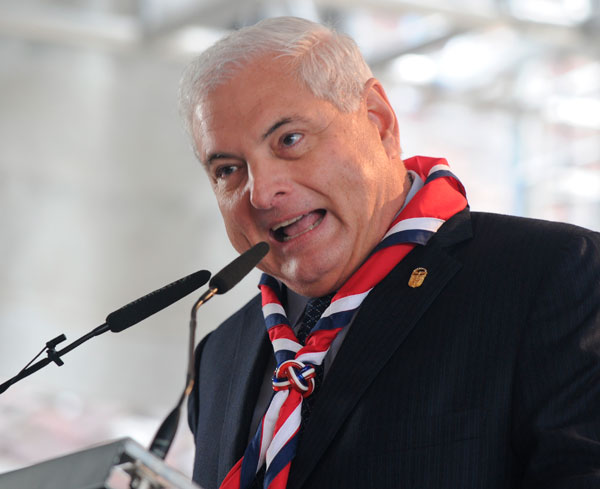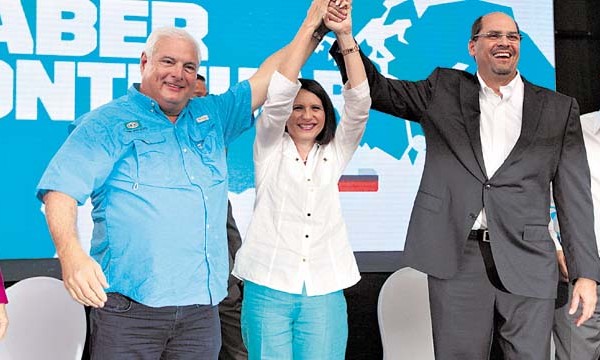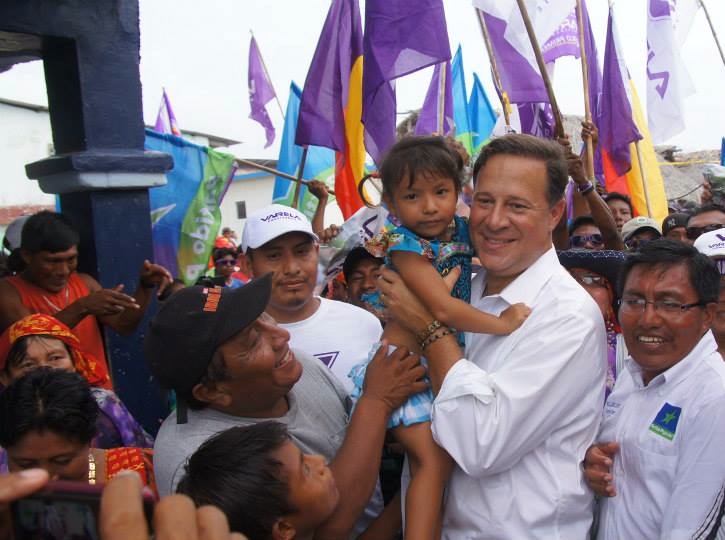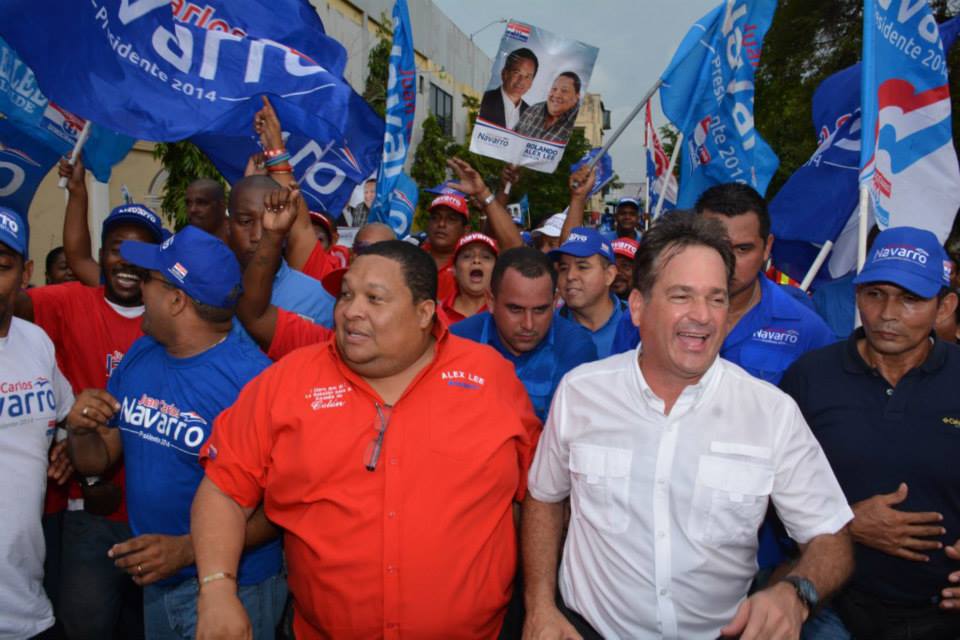If he could run for reelection, it seems certain that Ricardo Martinelli, the grocery chain tycoon-turned-politician, would almost certainly win a second term in office — he’ll leave the Panamanian presidency this year with approval ratings in excess of 60%.![]()
But with Panama’s law prohibiting consecutive terms, the closest Martinelli can come to a second term is by supporting the ticket of his own center-right Cambio Democrático (CD, Democratic Change), whose vice-presidential candidate is Panama’s first lady, Marta Linares de Martinelli.
* * * * *
RELATED: The internal politics of the widening of the Panama Canal
* * * * *
Martinelli has a strong record. Panama’s economy has grown by an average of between 8% and 9% through his five-year term (significantly boosted by the revenues garnered from the country’s eponymous canal.). He’s also introduced supplementary pensions for Panamanians over 70, built Panama City’s metro system, and spent around $20 billion on infrastructure projects. That includes the $5.25 billion Panama Canal expansion initiated by his predecessor, though the expansion has faced cost overruns and worker strikes that have postponed the expected completion date from 2015 to 2016.
He’s faced accusations, however, that he’s undermined Panamanian democracy, bullied opponents and presided over such a culture of corruption that Martinelli himself may face bribery charges in Italy after leaving office.
Critics argue that the CD’s presidential candidate, José Domingo Arias, another former businessman who served two years as minister for foreign trade and three years as minister for housing and land development under Martinelli, is merely a figurehead. They worry that if Martinelli’s wife (pictured above with Martinelli and Arias) is vice president, the incumbent will continue to control too much power in Panama. Despite a constitutional provision that appears to limit family members of the incumbent from running for president or vice president, Martinelli’s allies on the Panamanian supreme court have not blocked Linares’s vice presidential candidacy. But there’s also a sense that most Panamanians realize this going into the weekend’s vote.
In a fierce column for the Wall Street Journal last month, Mary O’Grady chastised Martinelli for trampling Panamanian democracy. She was shocked (shocked!) that a Central American president may have promised greater spending in exchange for a parliamentary majority over the past five years, and she ultimately compared Martinelli (unconvincingly) to Nicaraguan strongman Daniel Ortega:
In 2012, Mr. Martinelli tried to pack the Supreme Court by adding three new seats to guarantee his influence and raise the odds that he might overcome the prohibition on re-election the way Daniel Ortega did in Nicaragua. When Panamanians went to the streets to resist, he withdrew the proposal. The lust for power remains.
It’s worth noting that even in Costa Rica, which has the best governance standards in all of Central America, two recent former presidents have been convicted of corruption. It’s also a pretty rich argument for a columnist in a country where the frontrunners for the 2016 presidential election are the wife of a former president (Hillary Clinton) and the son and brother of two former presidents (Jeb Bush). Martinelli himself took to Twitter to attack her in a fairly petty retort, which wasn’t perhaps the most convincing step.
All pearl-clutching aside, and without getting into the theoretical question of ‘good corruption’ and ‘bad corruption,’ Martinelli certainly isn’t the first Latin American president on the right or the left to chafe at term limits. Though initially instituted to prevent the kind of personality-based caudillos that had a tendency to co-opt presidential systems throughout Latin America in the 19th and 20th centuries, strict one-term limits make presidents from Mexico to Chile lame ducks from the first day of their administrations. It’s not surprising that politicians like Martinelli (and like former Honduran president Manuel Zelaya) are looking for ways to escape the yoke of single term limits.
The two main challengers to Arias come from Panama’s two traditional parties.
The conservative Partido Panameñista (Panameñista Party) dates to the 1930s, it opposed the military rule of Omar Torrijos in the 1970s and the narcocratic rule of Manuel Noriega in the 1980s, and it draws much of its support today from rural Panamanian strongholds. It supported Martinelli in the 2009 presidential election, and in exchange, Martinelli chose Juan Carlos Varela (pictured above) as his running mate. Varela, who served two years as foreign minister, broke with Martinelli three years ago after he became embroiled in his own money laundering and corruption scandal. Varela is running against Arias in 2014, thereby splitting the conservative vote in Sunday’s election. Though the Panameñista Party is a much more established party than the CD, there’s a real chance that the CD might permanently supplant it as Panama’s chief conservative party if Arias wins the election.
The center-left Partido Revolucionario Democrático (PRD, Democratic Revolutionary Party) was actually founded by Torrijos in 1979, and the party somehow survived Noriega’s parasitic manipulation to become Panama’s chief center-left party today. It launched a wide-ranging and democratizing restructure after Panama’s return to democracy in 1990, and it’s traded power with the Panameñista Party in every election between 1990 and 2009, when the CD first won the presidency.
Most recently, under president Martín Torrijos (the late general’s illegitimate son), the PRD guided Panama through a free-trade agreement with the United States and inked a deal to widen the Panama Canal.
The PRD candidate, Juan Carlos Navarro, a businessman who formed ANCON, a leading environmental NGO in the 1980s, and who served as mayor of Panama City between 1999 and 2009, overseeing a building boom that’s solidified the capital’s role as the financial and travel hub of Central America.
Polls show the three candidates in a competitive race, with Arias and Navarro essentially tied and slighting leading Varela. An Ipsos poll released on April 23 showed Navarro with 34.2% and Arias with 33.9% and Varela trailing (narrowly) with 29.1%. Panamanian election don’t feature a runoff, so the winner of the greatest number of votes on Sunday will become president.
Both Arias and Navarro have committed to continue many of the policy accomplishments of the Martinelli administration, including its focus on infrastructure and social spending, both candidates largely embrace neoliberal economic policy, and both candidates seem likely to continue strong ties between Panama and the United States. What’s more, the next president will be responsible for seeing through the Panama Canal expansion that the PRD’s Torrijos began last decade.
One of the key differences is that a Navarro administration might be expected to audit the excesses of the Martinelli administration much more aggressively than an Arias administration — that would establish a strong precedent to limit future corruption.
But the next president won’t likely be able to count on the same rate of growth that Martinelli enjoyed over the past five years, notwithstanding the global financial crisis, though Panama’s growth prospects remain relatively strong. His successor will also be constrained by the growth of Panamanian public debt over the past five years (now nearly 40% of GDP) and a new law that attempts to limit fiscal deficits in the future.
In the simultaneous parliamentary elections, voters will choose all 71 members of Panama’s unicameral Asamblea Nacional (National Assembly) in single-member districts on a first-past-the-post basis. Going into the election, the CD holds just 14 seats, but it governs in alliance with the Panameñista Party (with 22 seats) and two other minor parties. The opposition PRD holds 26 seats, making it the largest party in the National Assembly.



